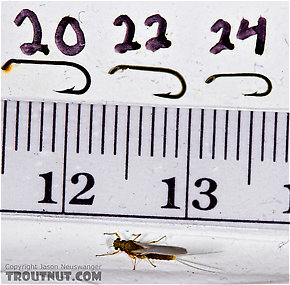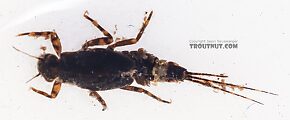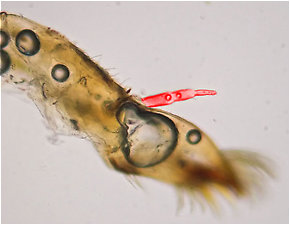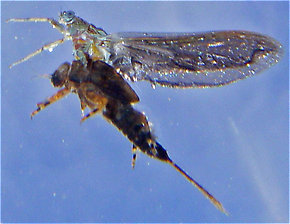Blog & Latest Updates
Fly Fishing Articles
Insects by Common Name


Mayfly Species Attenella margarita (Little Western Blue-Winged Olive)
Taxonomic Navigation -?-
Kingdom
Animalia (Animals)
» Phylum
Arthropoda (Arthropods)
» Class
Insecta (Insects)
» Order
Ephemeroptera (Mayflies)
» Genus
Attenella
» Species margarita (Little Western Blue-Winged Olive)
Common Names
Where & When
Region: West
Time Of Year (?): August
Hatching Behavior
Fred Arbona in Mayflies, the Angler, and the Trout says that trout prefer nymphs on the surface when the margaritas are hatching, so a floating nymph is the ideal tactic. He also says this hatch is unusually prone to producing stillborn (Stillborn: In fly fishing, a stillborn insect is one which got stuck in its nymphal or pupal shuck during emergence and floats helplessly on the surface instead of flying away. It is a specific class of cripple, although it is sometimes used interchangeably with that term.) and crippled duns.
However, Knopp and Cormier say that this species, like Attenella attenuata, emerges on the bottom of the stream and rises to the surface as a dun. This conflicts with Arbona's observation.
It may be that the nymphs of this species make several failed trips to the surface, like most in the family Ephemerellidae do, before deciding to emerge, and that Arbona observed feeding during this behavior. Or there may be a wider range of emergence behavior during this hatch than either author realized.
Spinner Behavior
Time Of Day: Late dusk
Nymph Biology
Current Speed: Slow
Environmental Tolerance: Best in consistently cold water
Pictures of 2 Mayfly Specimens in the Species Attenella margarita:
Female Attenella margarita (Little Western Blue-Winged Olive) Mayfly Dun View 6 PicturesI found this dun unusually late in the year for anything in the Ephemerellidae family in the East. It's also small for that family.
View 6 PicturesI found this dun unusually late in the year for anything in the Ephemerellidae family in the East. It's also small for that family.
 View 6 PicturesI found this dun unusually late in the year for anything in the Ephemerellidae family in the East. It's also small for that family.
View 6 PicturesI found this dun unusually late in the year for anything in the Ephemerellidae family in the East. It's also small for that family.Collected September 4, 2006 from Willowemoc Creek in New York
Added to Troutnut.com by Troutnut on October 3, 2006
Added to Troutnut.com by Troutnut on October 3, 2006
Attenella margarita (Little Western Blue-Winged Olive) Mayfly Nymph View 7 PicturesNotes from the microscope on the ID: Maxillary palp (
View 7 PicturesNotes from the microscope on the ID: Maxillary palp ( Palp: A long, thin, often segmented appendage which can protrude from certain insect mouth parts such as the maxillae. Also known as the < />palpus.) is present, distinctly 2-segmented, but very small. Gills on segment 4-7. This specimen has some unfortunate damage to the abdomen, but it's the only one I found in my sample.
Palp: A long, thin, often segmented appendage which can protrude from certain insect mouth parts such as the maxillae. Also known as the < />palpus.) is present, distinctly 2-segmented, but very small. Gills on segment 4-7. This specimen has some unfortunate damage to the abdomen, but it's the only one I found in my sample.
 View 7 PicturesNotes from the microscope on the ID: Maxillary palp (
View 7 PicturesNotes from the microscope on the ID: Maxillary palp (
The palp on the maxilla of an Ephemerella nymph (detached and photographed under a microscope) is highlighted in red here.
Collected August 3, 2020 from the East Fork Big Lost River in Idaho
Added to Troutnut.com by Troutnut on August 19, 2020
Added to Troutnut.com by Troutnut on August 19, 2020
Your Thoughts On Attenella margarita:
Top 10 Fly Hatches
Top Gift Shop Designs
Eat mayflies.
Top Insect Specimens
Miscellaneous Sites
Troutnut.com is copyright © 2004-2024 Jason
Neuswanger (email Jason). See my FAQ for information about use of my images.
 privacy policy
privacy policy

